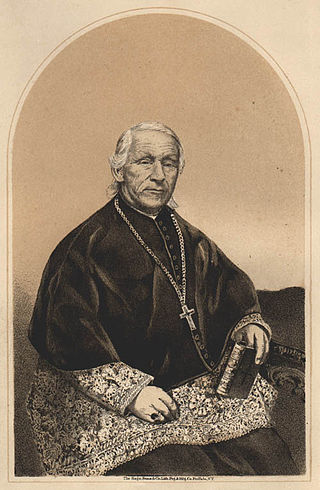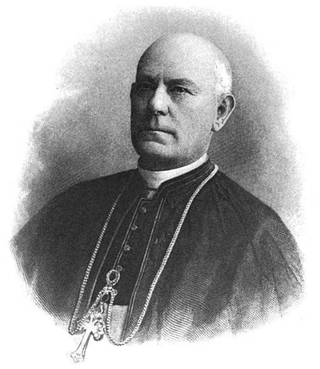Related Research Articles

Apostolic succession is the method whereby the ministry of the Christian Church is considered by some Christian denominations to be derived from the apostles by a continuous succession, which has usually been associated with a claim that the succession is through a series of bishops. Those of the Catholic, Eastern Orthodox, Anglican, Church of Sweden, Oriental Orthodox, Church of the East, Hussite, Moravian and Old Catholic traditions maintain that "a bishop cannot have regular or valid orders unless he has been consecrated in this apostolic succession". These traditions do not always consider the episcopal consecrations of all of the other traditions as valid.

Ansbach is a city in the German state of Bavaria. It is the capital of the administrative region of Middle Franconia. Ansbach is 40 kilometers southwest of Nuremberg and 140 kilometers north of Munich, on the river Fränkische Rezat, a tributary of the river Main. In 2020, its population was 41,681.

William J. Quarter was an Irish American prelate of the Catholic Church. He was the first Bishop of Chicago (1844–1848).

John Baptist Purcell was an American prelate of the Catholic Church. He served as Bishop of Cincinnati from 1833 to his death in 1883, and he was elevated to the rank of archbishop in 1850. He formed the basis of Father Ferrand, the Ohio-based "Irish by birth, French by ancestry" character in the prologue of Willa Cather's historical novel Death Comes for the Archbishop who goes to Rome asking for a bishop for New Mexico Territory.

Joseph Elmer Ritter was an American prelate of the Catholic Church. He served as Archbishop of St. Louis from 1946 until his death in 1967, and was created a cardinal in 1961. He previously served as auxiliary bishop (1933–1934) and bishop (1934–1946) of the Archdiocese of Indianapolis. Ritter was one of the cardinals elector who participated at the papal conclave in 1963.

The Archdiocese of Cincinnati is a Latin Church ecclesiastical jurisdiction, or archdiocese, of the Roman Catholic Church that covers many dioceses throughout the State of Ohio in the United States.

William Wakefield Baum was an American prelate of the Catholic Church. He served as the Bishop of Springfield-Cape Girardeau (1970–1973) and Archbishop of Washington (1973–1980) before serving in the Roman Curia as prefect of the Congregation for Catholic Education (1980–1990) and the major penitentiary (1990–2001).

The Evangelical and Reformed Church (E&R) was a Protestant Christian denomination in the United States. It was formed in 1934 by the merger of the Reformed Church in the United States (RCUS) with the Evangelical Synod of North America (ESNA). A minority within the RCUS remained out of the merger in order to continue the name Reformed Church in the United States. In 1957, the Evangelical and Reformed Church merged with the majority of the Congregational Christian Churches (CC) to form the United Church of Christ (UCC).

Henry K. Moeller was an American prelate of the Catholic Church. He served as bishop of the Diocese of Columbus in Ohio (1900–1903) and archbishop of the Archdiocese of Cincinnati in Ohio (1904–1925).

John Timothy McNicholas, O.P. was an Irish-born prelate of the Roman Catholic Church. A Dominican, he served as bishop of the Diocese of Duluth in Minnesota (1918–1925) and archbishop of the Archdiocese of Cincinnati in Ohio (1925–1950).

John Timon, C.M. was a prelate of the Roman Catholic Church. He served as the bishop of the new Diocese of Buffalo in Western New York and founder of the brothers of the Holy Infancy religious order.
David William Bacon was an American prelate of the Roman Catholic Church. He served as the first bishop of the Diocese of Portland in Maine and New Hampshire from 1855 until his death in 1874.
William Poynter was an English Catholic priest, bishop as vicar apostolic in London.

John Lancaster Spalding was an American Catholic author, poet, advocate for higher education, the first Bishop of Peoria from 1877 to 1908. He was also a co-founder of The Catholic University of America.

Augustine Francis Hewit was an American Redemptorist priest, and second Superior General of the Paulist Fathers.

Henry Cosgrove was a late 19th-century and early 20th-century bishop of the Catholic Church in the United States. He served as the second bishop of Diocese of Davenport in Iowa from 1884 to until his death in 1906.
Lutheranism is a major branch of Protestantism, identifying primarily with the theology of Martin Luther, the 16th-century German monk and reformer whose efforts to reform the theology and practices of the Catholic Church launched the Protestant Reformation.

Edward Mary Fitzgerald was an Irish-born American prelate of the Roman Catholic Church. He served as bishop of the Diocese of Little Rock in Arkansas from 1867 until his death in 1907.
John George Alleman was a missionary Catholic priest who served in the states of Ohio, Iowa and Illinois. He served as a priest in the Dominican Order from 1834 to 1840, after which time he was expelled from the order. He then served as a secular priest in the Diocese of Dubuque from 1840 to 1851, and in the Diocese of Chicago from 1851 to 1863. During his hospitalization in St. Louis, Missouri, (1863–1865) he was accepted back into the Dominican Order.
Der Wahrheitsfreund or Der Wahrheits-Freund was the first German language Catholic newspaper in the United States, and one of many German-language newspapers in Cincinnati, Ohio during the nineteenth century. It was published by the Roman Catholic Archdiocese of Cincinnati, and proceeds went to the St. Aloysius Orphan Society.
References
- 1 2 3 4 McGirr, John E. (1920). Life of the Rt. Rev. Wm. Quarter, D.D., First Catholic Bishop of Chicago. St. Mary's Training School Press. pp. 37–41. Retrieved 27 September 2023.
- 1 2 3 Ferris, Michele Mosser (2020). The Religious Bildungsbürgertum in the Queen City: Race and Cultural Politics in Cincinnati’s German Denominational Newspapers, 1830–1862 (PhD). The University of Chicago ProQuest Dissertations Publishing. Retrieved 27 September 2023.
- 1 2 Purcell, Edward (11 April 1840). "Cincinnati: Saturday, April 11, 1840". The Catholic Telegraph. Archdiocese of Cincinnati. Retrieved 27 September 2023.
- ↑ White, Joseph M. (Summer 1994). "Cincinnati's German Catholic Life: A Heritage of Lay Participation". U.S. Catholic Historian. 12 (3): 1. Retrieved 27 September 2023.
- Attribution
- Catholic News (New York, 18 April 1908) The entry cites:
- U.S. Cath. Hist. Soc., Hist. Records and Studies, IV, parts I and II (New York, Oct., 1906);
- John Gilmary Shea, The Cath. Church in. the U. S. (New York, 1856);
![]() This article incorporates text from a publication now in the public domain : Herbermann, Charles, ed. (1913). "John James Maximilian Oertel". Catholic Encyclopedia . New York: Robert Appleton Company.
This article incorporates text from a publication now in the public domain : Herbermann, Charles, ed. (1913). "John James Maximilian Oertel". Catholic Encyclopedia . New York: Robert Appleton Company.